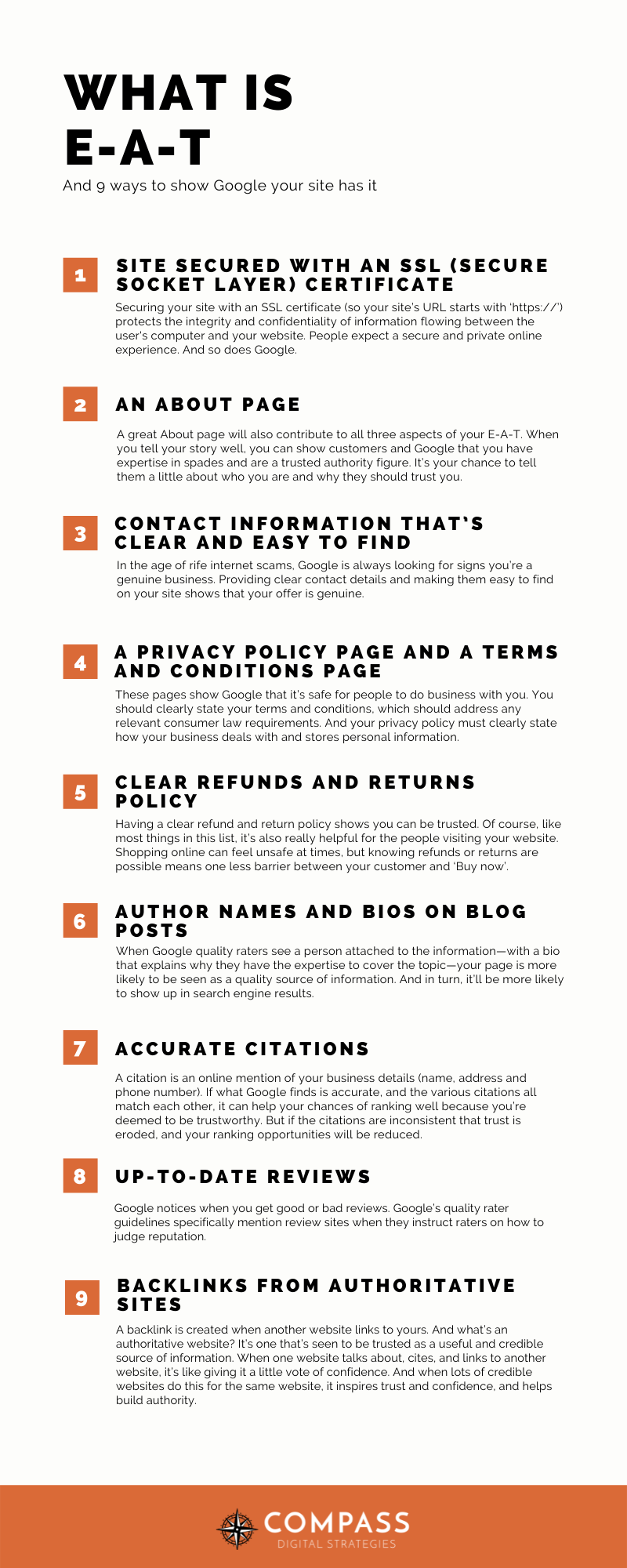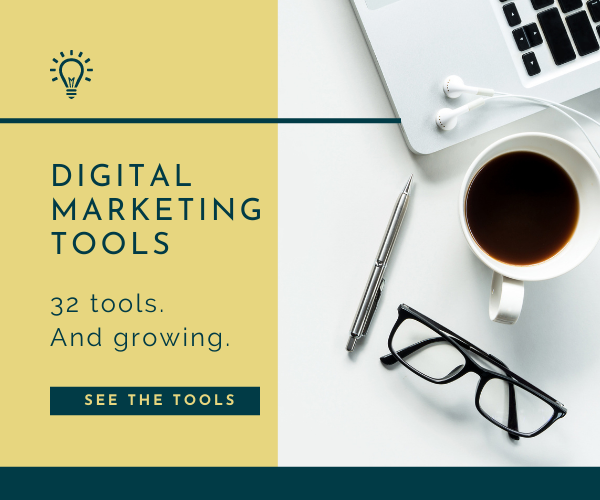Right now you’re probably thinking, What on earth is E-A-T?
Well, E-A-T stands for Expertise, Authority and Trustworthiness.
It’s something search engines look at to determine your web page’s quality.
And it’s important, because higher the quality of your web page, the more likely it will appear in search results and the more visitors (and traffic) you’ll get.
So let’s break it down. What is E-A-T, and how can you show Google your site has it?
What is E-A-T?
In SEO terms, E-A-T is a combination of three things search engines look at to determine the quality of your page:
- expertise, which shows your business is an expert on your topic.
- authority, which shows you’re a leader in your industry and a good source of information.
- trustworthiness, which shows you can be trusted to provide honest, truthful and accurate information.
The E-A-T framework also feeds into Google’s “Your Money, Your Life” (YMYL) guidelines.
YMYL pages are those Google believes could affect the “future happiness, health, financial stability or safety of users”.
In other words, the information or products on that page could have a substantial impact on the reader’s life.
Which means that Google wants to see more evidence that these pages come from a credible site.
Amongst other things, they want to see more E-A-T. These can include pages from sites such as:
- eCommerce stores
- financial advisory sites
- legal firms
- medical sites
- news websites.
It’s a branding thing
You may know of E-A-T as a branding term.
Yes, it’s a hot topic there, too.
But branding professionals come at it more from the audience’s perspective – looking at how potential customers (who are also persuaded by signs of expertise, authority, and trustworthiness) perceive your brand.
But for our purposes – being an SEO strategist – I’ll show you how you can apply E-A-T to technical SEO.
How to show Google you have E-A-T
Google likes to be mysterious at times, so there’s no document that explicitly outlines preferred E-A-T signals.
But there are some industry-agreed SEO tactics to help the Google bots out.
Here’s a simple list of common E-A-T signals that they pick up on.
- Site secured with an SSL (Secure Socket Layer) certificate
- An About page.
- Contact information that’s clear and easy to find.
- Privacy policy page and terms and conditions page.
- A clear refunds and returns policy (if yours is an eCommerce business)
- Author names and bios on blog posts.
- Accurate citations (directory listings and links to your social media accounts).
- Up-to-date reviews.
- Backlinks from authoritative sites.
Now let’s take a closer look at each of those.
Site secured with an SSL (Secure Socket Layer) certificate
Securing your site with an SSL certificate (so your site’s URL starts with ‘https://’) protects the integrity and confidentiality of information flowing between the user’s computer and your website.
People expect a secure and private online experience.
And so does Google.
Securing your site means it’s difficult for others to spy on conversations, steal information or hack into private systems.
And it helps you show your site is trustworthy.
An About page
Did you know the About page is one of the most visited pages of a website?
A great About page will also contribute to all three aspects of your E-A-T.
We can’t ask the question, What is E-A-T?, without discussing your About page.
When you tell your story well, you can show customers and Google that you have expertise in spades and are a trusted authority figure.
It’s your chance to tell them a little about who you are and why they should trust you.
But think of it like speed dating: you only have a quick chance to capture the reader’s attention.
So don’t waffle on about yourself.
Talk about how you can help them (and why they should choose you).
Contact information that’s clear and easy to find
This one contributes more to the ‘T’ in E-A-T: are you trustworthy?
In the age of rife internet scams, Google is always looking for signs you’re a genuine business.
Providing clear contact details and making them easy to find on your site shows that your offer is genuine.
A privacy policy page and a terms and conditions page
Your privacy policy and terms and conditions pages show Google that it’s safe for people to do business with you ( which goes back to the ‘T’ in E-A-T).
You should clearly state your terms and conditions, which should address any relevant consumer law requirements.
And your privacy policy must clearly state how your business deals with and stores personal information.
While getting them right may be time consuming, they’re worth having.
And not just from a legal standpoint. Having them on your site will also give it more E-A-T and help bring in more traffic.
It’s common to include links to these two pages in the footer of the page, where they can be easily accessed without making them part of the main navigation.
A clear refunds and returns policy (if yours is an eCommerce business)
Having a clear refund and return policy shows you can be trusted.
Google will add another tick to your E-A-T, and you’ll be more likely to show up in search results.
Of course, like most things in this list, it’s also really helpful for the people visiting your website.
Shopping online can feel unsafe at times, but knowing refunds or returns are possible means one less barrier between your customer and ‘Buy now’.
Author names and bios on blog posts

Including the author’s details on your blog posts helps with the ‘E’ in E-A-T – expertise.
When Google quality raters see a person attached to the information—with a bio that explains why they have the expertise to cover the topic—your page is more likely to be seen as a quality source of information.
And in turn, it’ll be more likely to show up in search engine results.
Accurate citations (with directory listings and links to your social media accounts)
A citation is an online mention of your business details (name, address and phone number).
The most common places to find citations are on business directories and social media platforms.
Citations obviously help people discover local businesses.
But they can also help (or hinder) your SEO efforts.
There are three main things to consider.
- The number of citations your business accrues.
- The accuracy of those citations.
- The quality of the websites they appear on.
Search engines such as Google trawl the internet to find your citations.
If what they find is accurate, and the various citations all match each other, it can help your chances of ranking well because you’re deemed to be trustworthy.
But if the citations are inconsistent that trust is eroded, and your ranking opportunities will be reduced.
Up-to-date reviews
Google notices when you get good or bad reviews.
Another way to improve your E-A-T rating is to keep tabs on review sites such as Yelp, Amazon, Better Business Bureau and Google Shopping.
Google’s quality rater guidelines specifically mention these sites when they instruct raters on how to judge reputation.
It may be tempting to just ignore bad reviews, but you shouldn’t.
You need to address them head on, as they can show you how to improve your customer service or make your website better.
Answering negative reviews can improve your SEO because those quality raters see you’re genuine and trying to improve things.
Remember E-A-T and always try to inspire trust.
Backlinks from authoritative sites
Another way to increase your E-A-T is to get as many relevant backlinks from authoritative websites as you can.
A backlink is created when another website links to yours.
And what’s an authoritative website?
It’s one that’s seen to be trusted as a useful and credible source of information.
When one website talks about, cites, and links to another website, it’s like giving it a little vote of confidence.
And when lots of credible websites do this for the same website, it inspires trust and confidence, and helps build authority.
Search engines will trawl a website’s backlinks to help judge their level of E-A-T.
So if you can get backlinks from a number of authoritative sites, it will build your own authority and help improve your search engine rankings.
Authoritative websites might be sites such as Forbes, The New York Times or the Centers for Disease Control and Prevention.
But they could also be much smaller operations such as popular how-to blogs or niche service providers.
They just need to be consistently trusted and regularly linked to by other credible sources.
Start improving your E-A-T
When we ask, What is E-A-T? We talk a lot about Google being a bunch of bots, AI and machines.
But it’s still driven by humans.
And they look at site pages in the same way we do.
They want to see good E-A-T factors.
If they don’t (eg the site looks like a throwback from the 90s), they’ll downgrade them.
But I’ve got good news.
There’s something really simple you can start working on to improve your E-A-T.
And that’s to set up your Google Business Profile with my free email course. It’ll help you start ticking many of these boxes.

